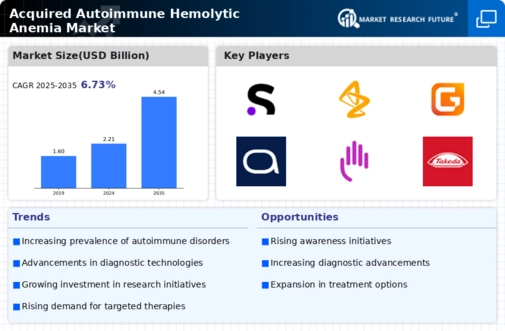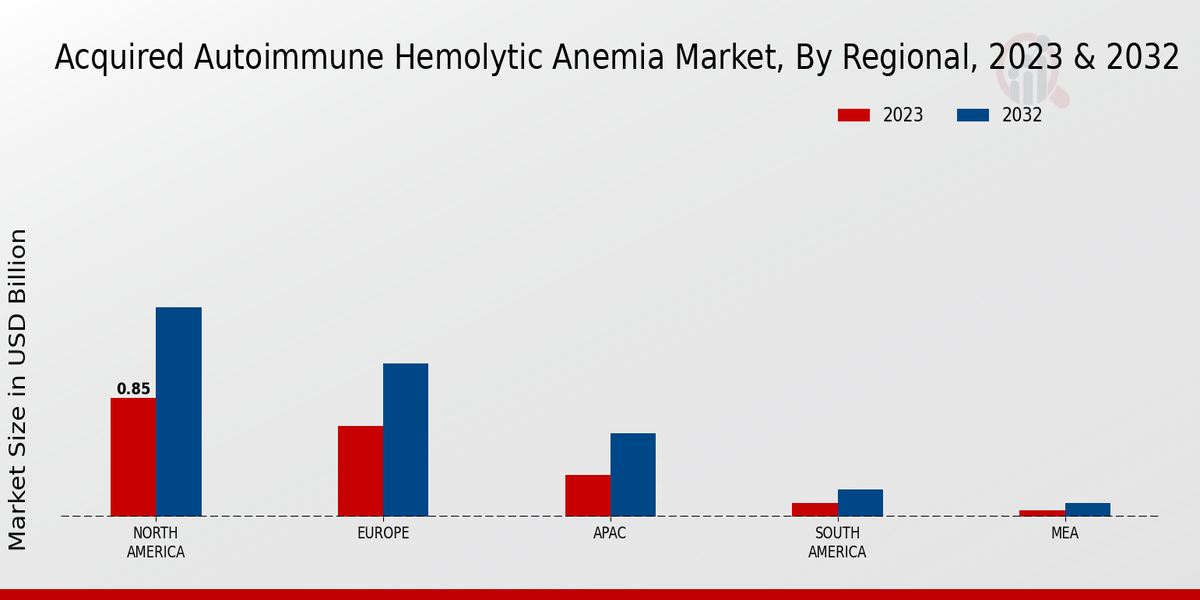Market Growth Projections
The Global Acquired Autoimmune Hemolytic Anemia Market Industry is projected to experience substantial growth in the coming years. With a market valuation of 2.21 USD Billion in 2024, it is anticipated to reach 4.54 USD Billion by 2035, reflecting a robust compound annual growth rate of 6.76% from 2025 to 2035. This growth trajectory indicates a strong demand for innovative treatments and increased awareness of the condition, positioning the market for significant advancements and opportunities in the near future.
Advancements in Diagnostic Techniques
Technological advancements in diagnostic methodologies are enhancing the identification of acquired autoimmune hemolytic anemia, thereby driving growth in the Global Acquired Autoimmune Hemolytic Anemia Market Industry. Improved blood tests and imaging techniques facilitate earlier and more accurate diagnoses, allowing for timely intervention. For instance, the development of high-throughput screening methods enables healthcare providers to detect hemolytic anemia more efficiently. As awareness of these advancements spreads, it is anticipated that the market will experience a notable increase, potentially reaching 4.54 USD Billion by 2035, as more patients are diagnosed and treated.
Rising Awareness and Education Initiatives
Increased awareness and educational initiatives regarding acquired autoimmune hemolytic anemia are playing a pivotal role in the Global Acquired Autoimmune Hemolytic Anemia Market Industry. Healthcare organizations and advocacy groups are actively promoting knowledge about the disease, its symptoms, and available treatment options. This heightened awareness encourages individuals to seek medical attention sooner, leading to earlier diagnoses and improved patient outcomes. As more people become informed about the condition, the demand for effective therapies is likely to rise, further propelling market growth in the coming years.
Aging Population and Associated Health Risks
The aging population worldwide is contributing to the growth of the Global Acquired Autoimmune Hemolytic Anemia Market Industry. Older adults are more susceptible to various health conditions, including autoimmune disorders, which increases the likelihood of developing acquired autoimmune hemolytic anemia. As the demographic shift towards an older population continues, healthcare systems must adapt to address the unique needs of this group. This trend is expected to drive market expansion, as healthcare providers seek to develop targeted therapies and management strategies for this vulnerable population.
Increasing Prevalence of Autoimmune Disorders
The rising incidence of autoimmune disorders globally contributes significantly to the Global Acquired Autoimmune Hemolytic Anemia Market Industry. As more individuals are diagnosed with conditions such as lupus and rheumatoid arthritis, the likelihood of developing acquired autoimmune hemolytic anemia increases. This trend is particularly evident in regions with higher autoimmune disease prevalence, suggesting a growing patient population that requires effective treatment options. The market is projected to reach 2.21 USD Billion by 2024, reflecting the urgent need for innovative therapies and management strategies to address this expanding demographic.
Growing Investment in Research and Development
The Global Acquired Autoimmune Hemolytic Anemia Market Industry is witnessing a surge in investment directed towards research and development initiatives. Pharmaceutical companies are increasingly focusing on developing novel therapies and biologics aimed at treating this condition. This trend is fueled by the recognition of unmet medical needs and the potential for lucrative returns on investment. As a result, the market is expected to grow at a compound annual growth rate of 6.76% from 2025 to 2035, reflecting the industry's commitment to innovation and the development of effective treatment modalities.
























Leave a Comment